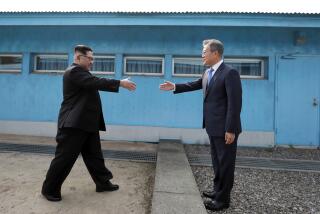Make Withdrawals Leverage for Peace : South Korea: Troop cuts, rather than being the fallout of budget needs, should be used as part of a constructive end game on the peninsula.
- Share via
The pressure is on to reduce U.S. troop strength in South Korea, and Seoul should be prepared to fill the gap. That is the message Secretary of Defense Dick Cheney took with him to Korea last week. Rather than simply scaling back the U.S. presence as the South Koreans take on a greater role in their own defense, Washington and Seoul should advance the prospects for peace on the peninsula by linking U.S. troop cuts to improvements in North-South relations.
Cheney and South Korean Defense Minister Lee Sang Hoon agreed that reducing the 43,000 American troops would be part of a broader restructuring of military relations in which Seoul will take on a greater share of defense responsibilities. The Bush Administration announced last month that three U.S. air bases in South Korea will be closed and 2,000 airmen withdrawn. Additional reductions of 3,000 personnel, now under review in the Pentagon, would return U.S. troop strength in Korea to the 1980 level. Budget pressures and concern over burden sharing may motivate Congress to seek deeper cuts. Last year, one-third of the Senate voted to withdraw 10,000 troops, and support for the plan is growing.
The South Korean government and all three opposition parties are not anxious to see a reduction in the U.S. military presence at this time. Their concern is not military but political. U.S. troops constitute less than 5% of the South Korean armed forces and could, under the restructuring, be replaced by Korean firepower. The symbolic and deterrent role of U.S. forces cannot, however, be replaced by Koreans. Seoul fears that unilateral reductions would send the wrong signal to North Korea about the durability of our commitment to the South.
In contrast to the historic changes in Eastern Europe, 1989 was not a “watershed year” in Northeast Asia. With more than 1.6 million troops facing each other across the 38th Parallel, the Korean peninsula remains an anomalous vestige of Cold War conflict. Nearly 1 million of those troops are under the control of the North Korean regime of Kim Il Sung, one of the few Stalinist dictatorships to survive the 1980s. Yet the totalitarian North, whose propaganda has been aimed at the American presence in the South since 1953, cannot remain removed from world changes for long. The fall of the Berlin Wall and the prospect of German reunification have special significance in this nation divided by World War II.
To promote positive change on the Korean peninsula in the 1990s, the United States and the Republic of Korea should forge a common policy that would use U.S. troop cuts as leverage to bring about improvements in North-South Korean relations. The increasing isolation of North Korea in the world community may provide an opportunity for progress in North-South talks, especially if we provide an appropriate face-saving vehicle as encouragement. The ultimate objective would be to withdraw all U.S. forces permanently stationed in South Korea, providing there is a marked reduction in military confrontation between the two Koreas, if not concrete steps toward reunification.
The first phase of this policy would involve unilateral reductions in U.S. troops. The United States and South Korea should make a virtue of necessity by characterizing the joint decision to reduce the level of U.S. noncombatant forces stationed in Korea as a gesture of good will toward the North and to seek a reciprocal and positive North Korean response. Such an approach was taken by President Roh Tae Woo in his New Year’s address when he stated that the scope of the annual U.S.-South Korean military exercise known as Team Spirit would be cut by 10%. So far, the North Korean response has been relatively encouraging. We should pursue a similar political approach to U.S. troop reductions this year.
After this initial reduction, the second phase would tie further U.S. troop cuts to meaningful steps by the North to reduce tension and military confrontation. At a minimum, such measures would include North Korean acceptance of international inspections of the nuclear-enrichment facility under construction north of its capital, Pyongyang, as well as steps aimed at reducing the capability and fear of a surprise attack along the demilitarized zone. The heavy concentration of forwardly deployed North Korean troops--as well as ammunition, fuel and bridging equipment--along the DMZ is particularly threatening. Specific confidence-building measures to reduce that offensive threat and create greater warning time in which American forces could be reintroduced would provide an opportunity to further reduce our forces.
Such a two-track framework by the U.S.-South Korean security alliance would establish a forward-looking policy toward the North. It would demonstrate a continuing U.S. security commitment to South Korea and underscore the political solidarity of our two governments in the pursuit of reduced tensions on the Korean peninsula. The alternative of budget-driven reductions or congressionally mandated withdrawals would do the opposite. There could be no better “end game” for America’s postwar involvement in Korea than to facilitate improved North-South relations as we move toward withdrawal of our troops in the South.
More to Read
Sign up for Essential California
The most important California stories and recommendations in your inbox every morning.
You may occasionally receive promotional content from the Los Angeles Times.













